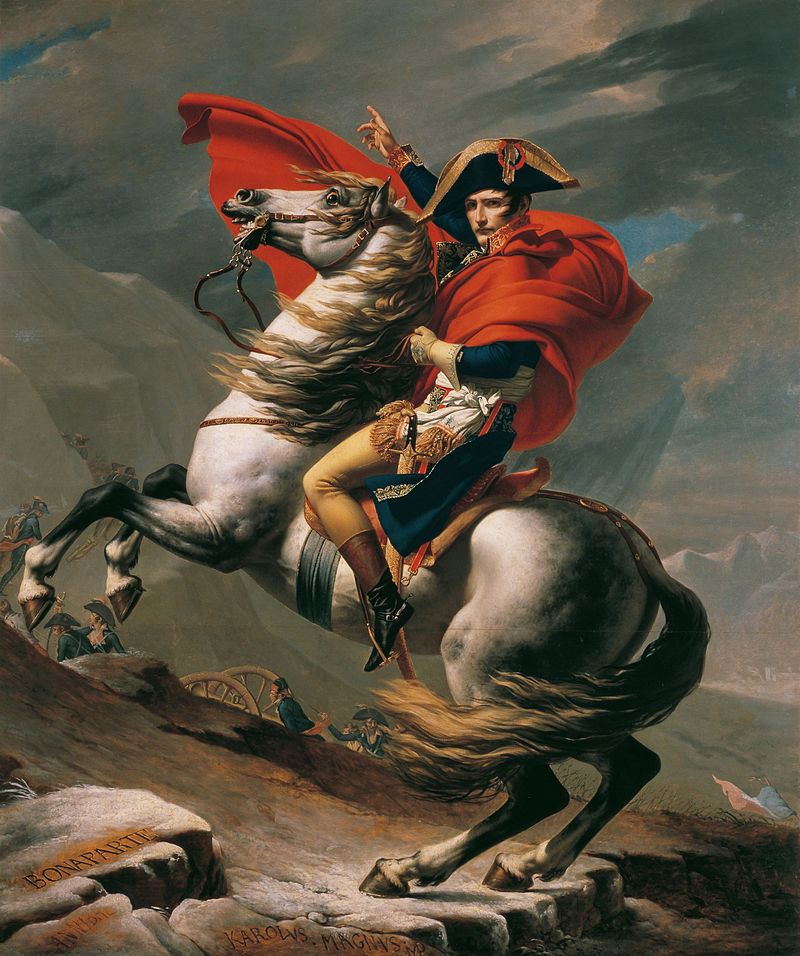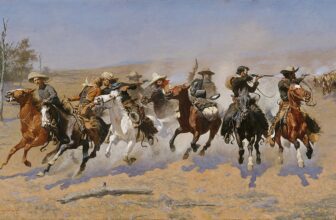
Napoleon Crossing the Alps: A Story Behind the Painting
The painting “Napoleon Crossing the Alps” by Jacques-Louis David is more than a mere depiction of an event; it is a masterful work of propaganda, encapsulating the spirit of a leader whose ambitions reshaped Europe. Through this exploration, we will delve into the historical context of the painting, its creation, symbolism, reception, and lasting influence. The story of Napoleon Crossing the Alps is one of art, power, and historical narrative converging into an iconic image.
Historical Context: The Second Italian Campaign
In May 1800, Napoleon Bonaparte led his troops across the Great St. Bernard Pass in the Alps to surprise Austrian forces in Italy during the Second Italian Campaign. At the time, Napoleon was not yet the Emperor of France but the First Consul, having seized power in the coup d’état of 1799. This campaign was pivotal for consolidating his power and restoring France’s dominance in Italy.
The crossing of the Alps was not an easy endeavor. While the painting romanticizes this moment as a heroic act, the reality was far grittier. The army faced treacherous conditions, including snow, ice, and narrow paths. They used mules and dismantled artillery pieces to traverse the rugged terrain. Despite these challenges, Napoleon’s forces emerged victorious at the Battle of Marengo, solidifying his reputation as a brilliant military strategist.
Commission and Creation
The painting was commissioned by Charles IV of Spain in 1801 as part of diplomatic efforts to strengthen ties with Napoleon. Jacques-Louis David, a leading neoclassical artist and a fervent supporter of the French Revolution, was the perfect choice for this task. David was already known for his works that combined classical ideals with contemporary political themes, making him an ideal propagandist for Napoleon’s regime.
Interestingly, five versions of this painting exist, each slightly different, created between 1801 and 1805. The first version was sent to Spain, while subsequent versions were created for French institutions and Napoleon himself. These iterations allowed David to refine his depiction of Napoleon, ensuring the image resonated with diverse audiences.
Symbolism and Composition
The painting captures Napoleon astride a rearing horse, clad in a billowing cloak, his gloved hand pointing forward. This heroic pose is steeped in symbolism:
- The Horse: The rearing horse represents strength and power. In reality, Napoleon crossed the Alps on a mule, but the horse elevates him to a mythic status, echoing classical equestrian statues of great leaders like Alexander the Great or Marcus Aurelius.
- The Cloak: Napoleon’s red cloak is both dramatic and symbolic, representing passion, energy, and leadership. The flowing fabric adds dynamism to the composition, enhancing the sense of movement and urgency.
- The Background: The jagged peaks of the Alps serve as a stark contrast to Napoleon’s calm demeanor, emphasizing his ability to conquer nature’s challenges. The turbulent sky further dramatizes the scene, underscoring the heroism of the moment.
- Engraved Names: Inscribed on the rocks beneath Napoleon are the names of Hannibal and Charlemagne, two great leaders who also crossed the Alps. This allusion places Napoleon in the lineage of historical greatness, linking his actions to a legacy of conquest and ambition.
Propaganda and Purpose
Napoleon Crossing the Alps is not a documentary piece but a propaganda tool designed to cement Napoleon’s image as a fearless and visionary leader. The painting serves several purposes:
- Legitimization of Authority: At the time, Napoleon’s position as First Consul was relatively new. The painting portrays him as a strong, almost divine figure, legitimizing his rule in the eyes of both the French people and foreign powers.
- Unity and Inspiration: The image was meant to inspire loyalty and unity among the French populace. By presenting Napoleon as a leader who could overcome any obstacle, it instilled confidence in his ability to lead France to greatness.
- International Diplomacy: Commissioned for the Spanish king, the painting also served as a diplomatic gesture, showcasing Napoleon’s prowess and France’s cultural sophistication.
Artistic Techniques
Jacques-Louis David employed neoclassical techniques to create a timeless and authoritative image. Key aspects of his artistry include:
- Composition: The triangular structure of the painting, with Napoleon at its apex, draws the viewer’s eye upward, reinforcing his dominance.
- Color Palette: David uses a limited but striking palette, with warm reds and cool blues creating a balance between emotion and rationality.
- Attention to Detail: From the horse’s straining muscles to Napoleon’s serene expression, every detail contributes to the overall narrative of heroism and control.
Reception and Legacy
Upon its unveiling, Napoleon Crossing the Alps was widely celebrated. It became one of the defining images of Napoleon’s reign and was reproduced in various forms, including prints, sculptures, and even postage stamps. Over time, it has become synonymous with Napoleon’s legacy, embodying his charisma, ambition, and the mythos of his leadership.
However, the painting has also been subject to critique and reinterpretation. Modern historians and artists often highlight the discrepancy between the idealized image and the harsh realities of the Alpine crossing. Satirical versions, such as Kehinde Wiley’s contemporary reinterpretation featuring an African-American man in streetwear, challenge the traditional notions of power and representation embodied in David’s work.
Comparison to Other Works
David’s painting can be compared to other iconic depictions of leadership, such as:
- “Washington Crossing the Delaware” by Emanuel Leutze: Like David’s work, this painting dramatizes a pivotal military moment, emphasizing the leader’s courage and vision.
- Equestrian Statues: The tradition of equestrian statues, from Marcus Aurelius in ancient Rome to Peter the Great in St. Petersburg, serves as a visual antecedent to David’s portrayal of Napoleon.
The Man Behind the Image
Napoleon Bonaparte himself was deeply aware of the power of imagery. He once remarked, “A picture is worth a thousand words.” By commissioning works like Napoleon Crossing the Alps, he actively shaped his public persona, blending reality and myth to maintain his authority and inspire his followers.
While the painting depicts a singular moment, it encapsulates the broader narrative of Napoleon’s life, a tale of ambition, resilience, and the pursuit of glory. The image endures as a testament to his impact on history, both as a military leader and a master of self-promotion.
Napoleon Crossing the Alps by Jacques-Louis David is far more than a depiction of a historical event; it is a masterpiece of storytelling through art. Combining historical context, symbolic elements, and artistic prowess, the painting immortalizes Napoleon as a heroic figure, transcending the gritty realities of war. Its legacy continues to spark discussions about power, propaganda, and the ways leaders shape their narratives. By exploring this iconic work, we gain insight into the interplay between art and history, and how both are used to forge enduring legends




